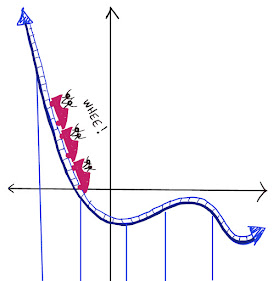For the solution, click "Read More" below.
There are different ways to reason through these problems. including by using the formula for a geometric series. Here are some ideas for reasoning through the problems without using the formula.
One-third of the square is shaded.
For this square we can focus one quarter since they differ only by a rotation.
Notice that we can think of this piece as a series of L-shaped pieces that get smaller and smaller. While the L's are all different in size, they each have the same fraction shaded.
Since 1/3 of each "L" is shaded, then 1/3 of the whole square is shaded.
Problem #2
Two-thirds of the square is shaded.
Notice that two-fourths are shaded completely, and then 1/3 of the other two-fourths are each 1/3 shaded for the same reason explained above. Adding the parts we get 1/2 + (1/3 x 1/2) = 2/3
Problem #3
Two-thirds of the square is shaded.
Notice that we can break down the square into Ls where each one is 2/3 shaded:










No comments:
Post a Comment
Note: Only a member of this blog may post a comment.